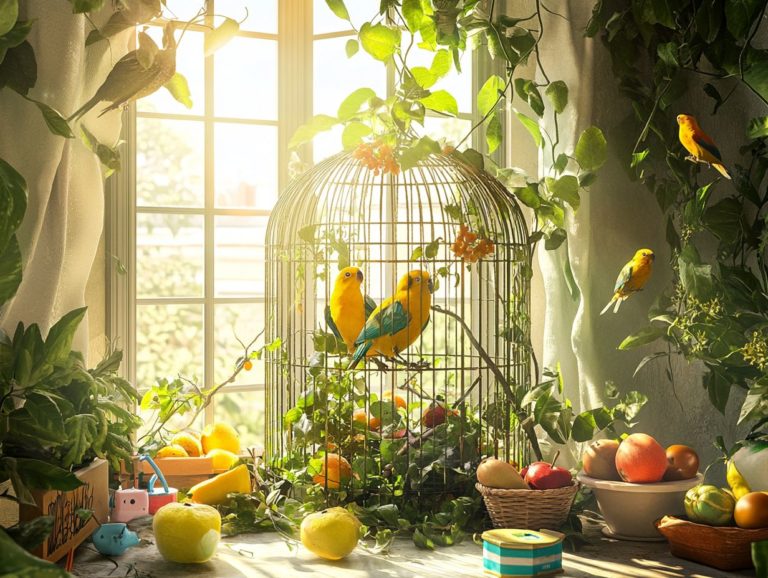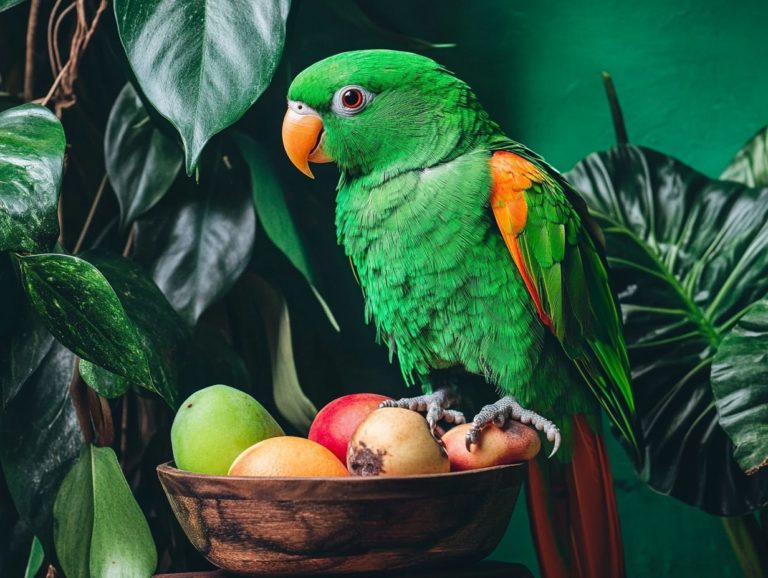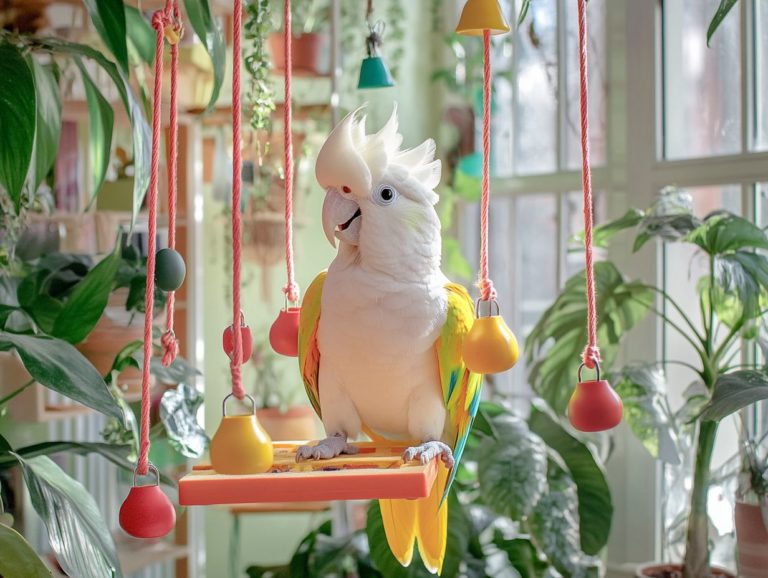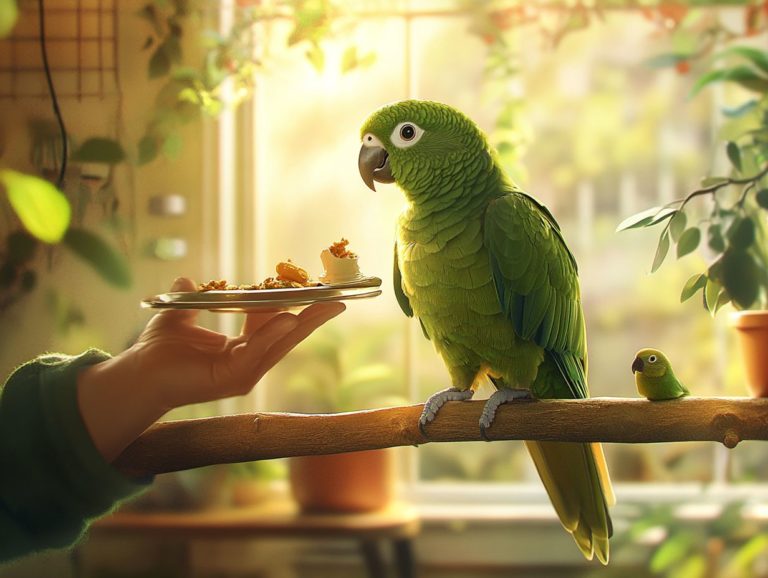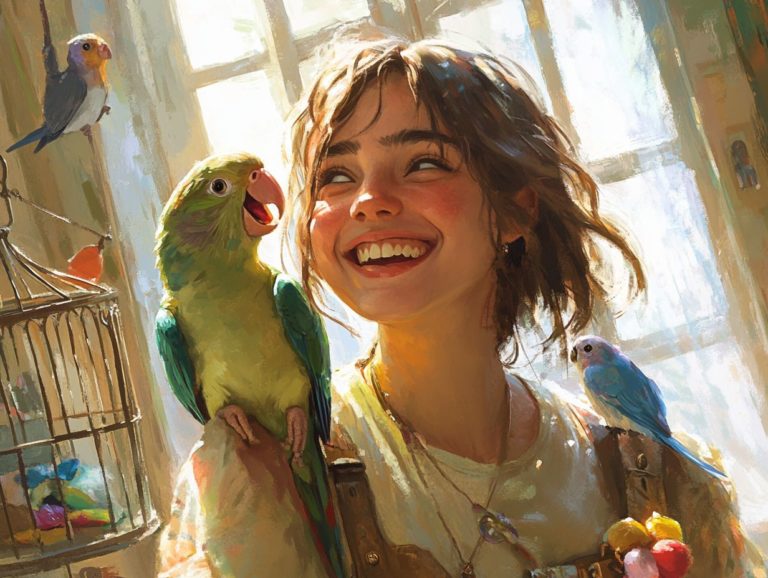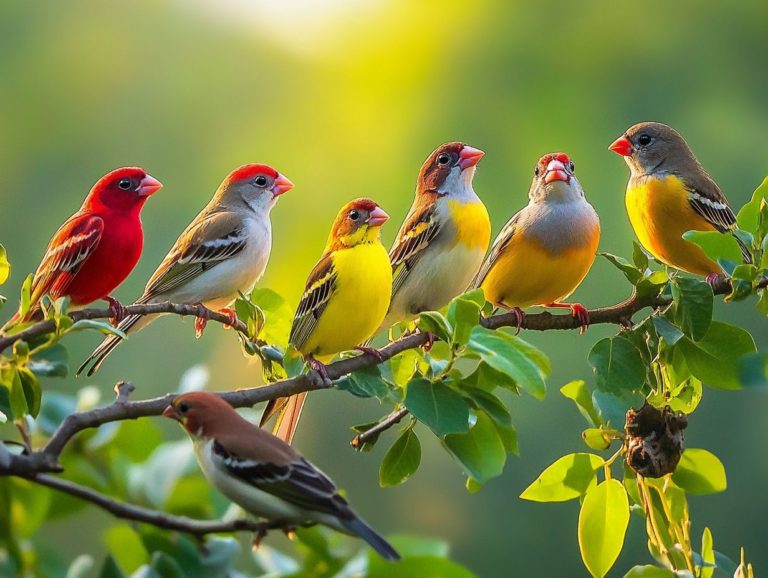5 Tips for Selecting the Right Bird Toys
Selecting the perfect toys for your feathered companion is crucial for their happiness and overall well-being. Get ready to transform your bird’s playtime into an exciting adventure!
This guide presents five essential tips to help you navigate the extensive range of choices available. By considering your bird s species and size, and recognizing the significance of natural behaviors, you ll learn how to choose toys that not only keep your avian friend engaged but also safe.
We will also answer your questions about toy safety, maintenance, and even share some fun DIY ideas. Don t wait! Elevate your bird s environment today for a happier life!
Contents
- Key Takeaways:
- 1. Consider Your Bird’s Species and Size
- 2. Look for Toys That Encourage Natural Behavior
- 3. Choose Toys with Different Textures and Materials
- 4. Avoid Toys with Small Pieces or Loose Parts
- 5. Rotate Toys Regularly to Keep Your Bird Entertained
- Why Are Toys Important for Birds?
- What Are Some Warning Signs That a Toy Is Not Suitable for Your Bird?
- How Can You Make Your Own Bird Toys at Home?
- What Are Some Popular Types of Bird Toys on the Market?
- Frequently Asked Questions
- What are the top 5 tips for selecting the right bird toys?
- How do I know if the bird toy is suitable for my bird’s size and species?
- Why is it important to choose bird toys made with safe, non-toxic materials?
- What type of stimulation should I look for in bird toys?
- How often should I rotate and introduce new bird toys?
- What should I look for when inspecting a bird toy for potential hazards?
Key Takeaways:
- Consider your bird’s species and size when selecting toys to ensure safety and engagement, particularly with different toy types that cater to parrot preferences.
- Look for toys that encourage natural behavior, such as foraging and climbing, to promote mental exercise and behavioral enrichment.
- Choose toys with a variety of textures and materials to keep your bird’s interest and prevent boredom.
1. Consider Your Bird’s Species and Size
When selecting bird toys, you must consider your bird’s species and size. Different birds, like African Grey parrots and cockatoos, have unique enrichment needs that are vital for promoting their physical and mental health through suitable playtime activities. To ensure you choose the right options, refer to this guide on how to choose safe bird toys for health and cognitive stimulation.
Each bird species comes with its own distinctive play styles and preferences. Some parrots thrive on puzzle toys that challenge their problem-solving skills, while others may gravitate towards toys that encourage physical manipulation or shredding.
It’s essential to choose toys that are appropriately sized to avoid any potential hazards. A toy that’s too small could pose a choking risk, while one that’s too large might just end up gathering dust. By recognizing species-specific behaviors like a cockatoo’s need for social interaction or the curious nature of an African Grey, you can select safe chew toys for your bird that not only keep them entertained but also enhance their overall well-being. This ensures they stay active and healthy.
2. Look for Toys That Encourage Natural Behavior
Choosing toys that encourage your parrot’s natural behaviors, like foraging and environmental interaction, is essential for providing mental exercise and enhancing their overall well-being.
For instance, consider foraging puzzles that require your feathered friend to solve challenges to access hidden treats; these can significantly engage their problem-solving skills. Interactive toys that respond to touch or movement can replicate the tactile experiences they would encounter in their natural habitats.
By introducing these types of toys, you not only promote behavioral enrichment but also help prevent common issues like pulling out feathers and destructive chewing. This kind of stimulation mimics the activities parrots would engage in while seeking food and socializing in the wild, ultimately leading to happier, healthier birds.
3. Choose Toys with Different Textures and Materials
When you select bird toys with a variety of textures and materials like wood, metal, and safe plastic components, you not only elevate your parrot’s playtime but also cater to its natural instincts for chewing and preening. To enhance your selection, check out the top 5 toys for training your bird.
These diverse options provide essential physical enrichment and stimulate mental engagement, ensuring your feathered friend stays active and entertained. By incorporating a range of materials, you enhance your bird’s emotional well-being, allowing it to experience different sensations that closely mimic its natural environment.
It’s crucial to ensure that all toys meet rigorous safety standards. This guarantees that the materials used are non-toxic and free from harmful substances. Your attention to both safety and material variety not only protects your bird s health but also fosters a profound sense of comfort and joy during playtime.
Start choosing the perfect toys for your feathered friend now and watch them thrive!
4. Avoid Toys with Small Pieces or Loose Parts
To ensure your bird’s safety, steer clear of toys with small pieces or loose parts. These can present choking hazards and may lead to serious health issues, so it’s also helpful to learn how to assess your bird’s toy preferences.
Also, regularly inspect your feathered friend’s toys for signs of wear and tear. Even the safest toys can wear out, potentially causing injuries.
Create a safety checklist that includes important criteria like materials, size, and durability. This will help you keep your pet safe while providing them with suitable toys.
Being vigilant about toy selection and maintenance is crucial for your bird’s well-being.
5. Rotate Toys Regularly to Keep Your Bird Entertained
Regularly rotating your bird’s toys keeps them entertained and engaged. This meets their enrichment needs and adapts to their changing preferences.
By refreshing their environment, you ll banish boredom and stimulate their minds. Different textures, colors, and sounds encourage exploration.
Consider rotating toys every two to four weeks. Watch your parrot’s reactions to see which toys they love most, helping you create a collection that delights them.
Why Are Toys Important for Birds?
Toys are vital for your bird’s mental health and overall well-being. They enhance quality of life and boost emotional health.
These toys do more than entertain; they help reduce behavioral issues in captive birds. Play allows social interaction, creating a community vital for intelligent and social species.
A stimulating environment with various toys improves cognitive health. The right toys enrich their lives, keeping them active and mentally sharp.
What Types of Toys Are Safe for Birds?
Safe toys should be made from non-toxic materials like wood and metal. Look for interactive toys that stimulate natural instincts.
Explore a variety of toys for your bird’s physical enrichment. Foraging toys, which encourage your bird to search for food, are particularly engaging, while chew toys keep their beaks healthy.
Avoid toys with small parts that can be choking hazards or those treated with harmful chemicals. Popular options include natural wooden perches and unscented cotton hammocks.
By prioritizing safety, you ensure a happy, healthy companion and countless opportunities for engaging playtime.
How Often Should Bird Toys Be Replaced?
Regularly inspect bird toys for wear and tear. Replace them to maintain safety standards and ensure your pet enjoys their toys.
Regular checks help you see when a toy needs replacing. Look for signs like fraying or cracking it s time for a new one!
Replacement frequency varies based on the toy type and your bird’s activity. Softer toys wear out faster. If your bird loses interest, introduce a new toy to keep their minds stimulated.
What Are Some Warning Signs That a Toy Is Not Suitable for Your Bird?
Recognizing the warning signs that a toy may not be suitable for your bird is crucial for preventing accidents and ensuring their bird safety. Look out for indicators such as signs of damage and your bird’s disinterest.
These signs can manifest as visible wear and tear think frayed edges, loose parts, or broken components. You might also notice a noticeable lack of engagement from your feathered companion. Regularly assessing toys for their suitability is essential in maintaining a safe environment for your bird.
To keep their play area secure, consider implementing a safety checklist that includes:
- Inspecting for hazardous elements
- Evaluating the material quality
- Ensuring the toy remains stimulating for your bird
By taking these steps, you not only create a safe habitat but also foster healthy interaction with their toys.
How Can You Make Your Own Bird Toys at Home?
Creating DIY bird toys at home can be an enjoyable and fulfilling way to enrich your pet s life using safe materials that align with their preferences and natural behaviors.
Tap into your creativity with a variety of textures, colors, and sounds. Design toys that not only entertain your feathered companion but also stimulate their innate instincts. To ensure safety, start by gathering bird-safe items and understanding how to choose safe materials for bird toys like untreated wood, leather pieces, and cotton ropes.
Consider adding foraging elements, such as crumpled paper (searching for food) or small containers, to hide treats and keep your bird intrigued.
Tailoring your creations to match your bird s unique play styles and preferences significantly enhances their physical and mental well-being, inspiring exploration and engagement. As you observe your pet interacting with their new toys, you strengthen your bond and ensure they have a truly enriching playtime experience.
What Are Some Popular Types of Bird Toys on the Market?
The market presents an impressive array of popular bird toys designed to engage and entertain your feathered friends. Discover exciting interactive toys that keep your bird entertained!
These toys come in various shapes and sizes, adorned with bright colors and textures that pique the curiosity of their inquisitive beaks. For example, climbing ropes and ladders not only offer physical exercise but also stimulate problem-solving skills as your birds navigate their playful environment.
Chewable toys crafted from natural wood satisfy their instinctual need to gnaw while helping to keep their beaks healthy and well-trimmed. Puzzle toys that dispense treats reward their intelligence and encourage foraging behaviors that mimic their natural instincts in the wild.
This diversity in bird toys enriches their lives and fosters a sense of security and well-being, ultimately leading to happier, healthier companions.
Frequently Asked Questions
What are the top 5 tips for selecting the right bird toys?
1. Consider your bird’s size and species to ensure the toy is appropriate.
2. Look for toys made with safe, non-toxic materials.
3. Choose toys that provide both mental and physical stimulation.
4. Rotate and introduce new toys regularly to prevent boredom.
5. Check for any sharp edges or small parts that could potentially harm your bird.
How do I know if the bird toy is suitable for my bird’s size and species?
Make sure to research your bird’s specific size and species to find the perfect toy. Consider exploring the top 5 bird toys for bonding with your pet and consult a veterinarian or bird expert for recommendations.
Why is it important to choose bird toys made with safe, non-toxic materials?
Birds are natural chewers and can easily ingest small pieces of toys. Choosing toys made with safe materials, such as those highlighted in the top 5 toys for helping birds stay active, ensures your bird’s safety and prevents potential health issues.
What type of stimulation should I look for in bird toys?
Birds are intelligent creatures that need mental and physical stimulation to stay happy and healthy. To keep your budgie engaged, consider exploring the top 5 bird toys for playful budgies that offer challenges, such as puzzles or foraging toys, as well as opportunities for physical activity like climbing or swinging.
Explore more about bird toys to give your feathered friends the best playtime experience!
How often should I rotate and introduce new bird toys?
Rotate your bird’s toys every 1-2 weeks.
Introduce new toys every 4-6 weeks to keep your bird engaged and entertained.
What should I look for when inspecting a bird toy for potential hazards?
Inspect toys for sharp edges, small parts, or loose strings that could harm your bird.
Ensure the toy is sturdy and cannot easily break apart or be swallowed.

